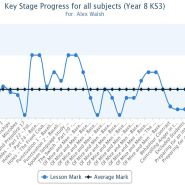September 2014 sees a major shakeup in the secondary school curriculum and assessment methods – and the indications are that many schools are still not fully prepared.
Admittedly, there has not been a great deal of time. It was only in June last year that the Secretary of State for Education, Michael Gove, dropped his bombshell.
He announced at the NCTL ‘Seizing Success’ conference that the new National Curriculum to be introduced in September 2014 would not involve existing National Curriculum assessment levels.
He stated:
“We will give schools the freedom to develop a curriculum which is relevant to their pupils and enables them to meet these expectations. Schools will be able to introduce their own approaches to formative assessment, to support pupil attainment and progression.
The assessment framework should be built into the school curriculum, so that schools can check what pupils have learned and whether they are on track to meet expectations at the end of the key stage, and so that they can report regularly to parents”.
It left schools with just over a year to rethink, reorganise and create a new curriculum and assessment system that could be introduced without too much disruption to pupils and staff.
Apart from KS4 English, Maths and Science; all the subject areas of the new National Curriculum have now been announced. A public consultation is to be held to ensure that the remaining three KS4 subjects are aligned with the new GCSEs to be introduced in the summer of 2017, and thus details will not be available until 2015.
Academies and Free Schools will not be required to deliver the new National Curriculum, but it will provide a standard against which an individual school curriculum can be measured.
Resources to help schools deal with the new requirements are limited. The Department for Education website contains sample assessment materials provided by publishers and models of various assessment systems. The government has stated that schools are responsible for their own in-school training, and the purchasing of appropriate resources.
GL Assessment is currently arranging a series of free ‘Life after Levels’ seminars and case studies showing how schools can use tests with national benchmarks to measure pupil progress. Judging by market research just carried out by BESA, teachers are seeking much more help as the majority of respondents indicated that they needed training from external providers.
The greatest need was for assistance on the subject of national benchmarking and how to devise their own assessment framework for tracking purposes.
Russell Hobby, general secretary of the NAHT commented, “We must take the Secretary of State at his word and take ownership of assessment.
Just because the government ceases to regulate something does not mean the profession must accept fragmentation. We can keep what was good about our previous system of assessment and address its flaws.”
In February 2014, the NAHT’s commission dealing with assessment changes recommended that:
- Schools should retain the use of levels while designing a new system
- Pupils should be judged against objective criteria rather than ranked against each other
- All assessments need external moderation and that the moderation needs real teeth
- Assessment should be driven by the curriculum
- Schools should adopt a consistent approach to assessment across the country
- Initial teacher training providers should improve training for assessment among new teachers
Schools recognise that the position of transient pupils moving from one school to another, particularly across different counties, will pose a problem. Trying to match standards from one school to another will not be easy.
Many schools have not yet fully decided. 44% of respondents to the BESA Market research indicated that they were unsure about as to whether they will stop using levels in future.
The majority of schools seem to be moving towards continuing to use existing levels for the time being, or for the adoption of a grade system linked to the GCSEs. Chris Hildrew, deputy head teacher at Chew Valley School Bristol, said “we wanted to create a clear ladder of attainment and the numeric GCSE grade system was chosen. We are 95% there at present.”
Another popular option is the use of competence, organisation, readiness, engagement (CORE) skills assessment methods. These require teachers to make subjective judgements on a scale of 1-5 as to each student’s demonstration of various skills:
Competence: Knowledge and the ability to use it in each lesson
Organisation: Preparedness for lessons, organisational skills
Readiness: Preparedness to learn, completion of homework
Engagement: Work effort and ethos
The use of the Cognitive Abilities Test (CAT) is used by many secondary schools to measure reasoning ability – verbal, non-verbal, quantitative and spatial reasoning. The results are then used to identify a pupil’s strengths, weaknesses and learning preferences.
What is clear to all schools is that decisions have to be made soon, for time is running out.










